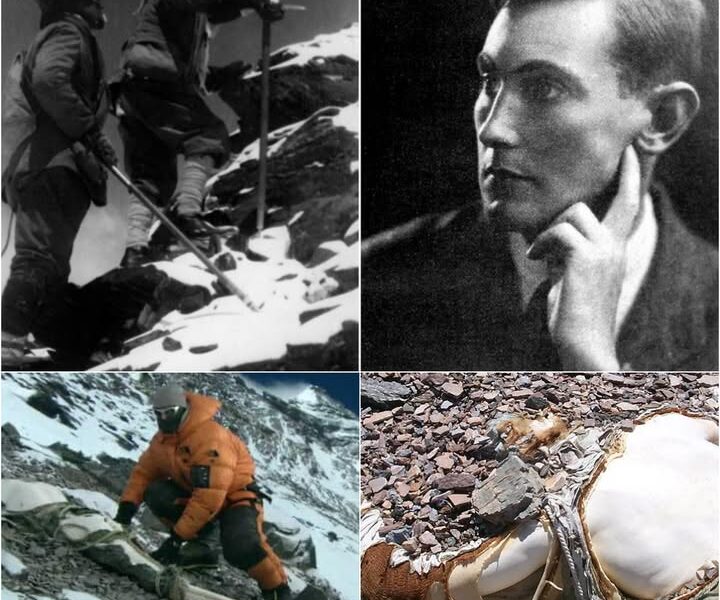75-YEAR-OLD EVEREST MYSTERY: Mallory’s Frozen Corpse Reveals HORRIFYING Final Moments!
In June 1924, British mountaineer George Mallory vanished on Mount Everest, leaving behind a question that haunts adventurers to this day: Did he become the first to summit the world’s highest peak, nearly three decades before Sir Edmund Hillary and Tenzing Norgay’s confirmed ascent in 1953? At 37, Mallory, a climbing legend, disappeared alongside partner Andrew Irvine, just 800 feet from Everest’s summit. His body, discovered 75 years later in 1999, offered clues but no closure. As we mark the centennial of his fateful climb, Mallory’s story captivates with its blend of courage, tragedy, and mystery.

A photo of a young George Mallory.
George Mallory, born June 18, 1886, in Mobberley, Cheshire, England, was a natural-born climber whose passion defined his life. Raised by a reverend and his wife, Mallory scaled church walls as a child, with his sister recalling, “He climbed everything that it was at all possible to climb,” per The New York Times. His talent shone at boarding schools, where he excelled in sports and mathematics. At 18, mentored by Alpine Club member Graham Irving, Mallory tackled the Alps, igniting a lifelong obsession. After graduating from Cambridge and working as a schoolmaster, he married Ruth Turner in 1914, fathering three children, and served in World War I. Yet, climbing remained his calling, culminating in his 1921 British Mount Everest reconnaissance expedition, which shifted his focus to the world’s tallest peak.

George Mallory (seated, far left) and planners of the reconnaissance expedition to Mount Everest in 1921.
The 1921 expedition, aimed at mapping routes to Everest’s 29,032-foot summit, identified a viable path via the North Col but left the team battered by exhaustion and altitude sickness, per PBS. In 1922, Mallory joined another British expedition, targeting the summit. It failed, marred by an avalanche and multiple unsuccessful attempts, with seven Sherpas perishing, per The Guardian. Undeterred, Mallory, at 37, returned in 1924, aware that age could soon limit him. “I can’t see myself coming back again after this,” he wrote, per Climbing Magazine. By late May, his team established Camp IV at over 20,000 feet on the North Col. After a teammate’s illness forced a brief descent, Mallory and Andrew Irvine, a 22-year-old Oxford rower, set out on June 6, 1924, from the North Col, determined to reach the summit.

George Mallory with fellow climber Andrew Irvine in the last photo of them on their fatal Everest climb in 1924.
On June 8, porters reported seeing Mallory and Irvine 800 feet below the summit, with Mallory confident of success, per the Royal Geographical Society. They never returned, sparking a mystery that endured for decades. Early clues emerged in 1933 when Percy Wyn-Harris found an ice axe near the summit, likely Irvine’s due to hand-carved nick marks, though Wyn-Harris claimed his Sherpa, Kusang Pugla, marked it to avoid loss, per PBS. In 1936, Frank Smythe reportedly spotted bodies via telescope, informing 1924 expedition leader Edward Norton privately, a detail revealed in 2013, per The Guardian. A 1975 Chinese expedition added intrigue when Wang Hongbao found an “English dead” body, likely Mallory or Irvine, per Outside Magazine. These fragments fueled speculation but offered no answers.

In 1999, the Mallory and Irvine Research Expedition, led by American climber Conrad Anker, used these clues to search Everest’s northern slopes. On May 1, Anker spotted what he thought was a rock but was Mallory’s body, preserved by the mountain’s permafrost, per National Geographic. Time had shredded his clothing, but his injuries—broken right leg, arm, and a rope-jerk wound—suggested a fatal fall, per The Guardian. The ice axe, found 200 feet above, hinted that Mallory and Irvine were roped together when disaster struck. Irvine’s body remains missing, and with it, a potential key: Mallory’s Kodak camera, carried by Irvine, could contain developable film proving a summit, per experts cited by BBC. Without it, the mystery persists—did they reach the top before falling?

The body of George Mallory as it was found on Mount Everest in 1999.
Mallory’s skill and resolve make a summit plausible. His 1921 route via the North Col, climbing at 7.7 meters per minute, outpaced many contemporaries, per the Alpine Journal. The 1924 expedition’s oxygen tanks, providing 2 liters per minute, boosted their chances, though the Second Step—a 100-foot rock face 1,000 feet below the summit—posed a formidable barrier. Modern climbers like Reinhold Messner argue the step was climbable for Mallory, given his Alpine prowess, but others, like historian Tom Holzel, note the era’s rudimentary gear—cotton layers, leather boots—limited endurance, per Outside. Mallory’s final note, found in his pocket, detailed oxygen supplies but no summit confirmation, per the Royal Geographical Society. X posts, like @MountEverestHQ’s “Mallory’s body solved part of the puzzle, but the summit question lingers,” reflect ongoing fascination.
The expedition’s context underscores the stakes. The 1920s British quests, backed by the Royal Geographical Society, aimed to claim Everest for national pride post-World War I. Mallory’s drive, evident in his famous “Because it’s there” quote, per The New York Times, embodied this ambition. Yet, the mountain’s dangers—30% oxygen levels at 29,000 feet, per NOAA, and temperatures below -30°F—tested human limits. Of 26 climbers who died on Everest before 1924, most succumbed to falls or avalanches, per the Himalayan Database. Mallory’s injuries align with a fall, but whether it occurred during ascent or descent remains unclear. If Irvine’s body is found with the camera, experts believe 1920s Kodak film could still yield images, per Smithsonian Magazine, potentially rewriting history.

The mystery captivates because it challenges our understanding of human endurance. Mallory’s body, found at 26,800 feet, suggests he was tantalizingly close. His daughter Clare later said, “To me, he climbed it,” per PBS, reflecting family belief. Yet, skeptics argue the Second Step’s 5.10-grade climb, per modern ratings, was too steep without modern aids. X debates, like @ClimbingHistory’s “Mallory had the skill, but not the tech,” highlight the divide. The 1999 find, covered by National Geographic, spurred renewed searches for Irvine, with a 2019 drone expedition yielding no results, per Outside. Mallory’s legacy endures, inspiring climbers like Anker, who summited Everest in 2007, to honor his “audacity,” per Climbing Magazine.
George Mallory’s 1924 disappearance on Everest remains one of mountaineering’s greatest enigmas. His body’s discovery in 1999 confirmed a tragic fall but left open the question of whether he summited before Hillary and Norgay. Mallory’s courage, skill, and the tantalizing clues—ice axe, unseen camera—keep his story alive, fueling debates about human limits and exploration’s cost. As we reflect on his legacy, #Everest climbers and fans ask: Did Mallory conquer the peak?




